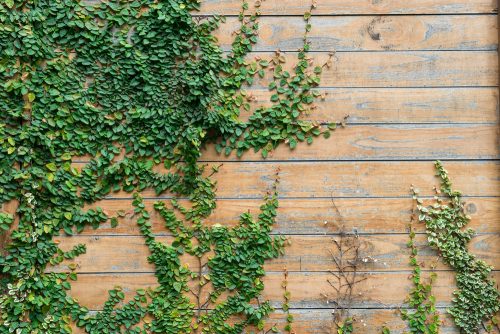Outdoor Ivy: Fences and Walls

Using outdoor ivy is perfect for creating privacy and increasing your home’s personality.
Climbing ivy is an excellent option if you’re looking to create more privacy in your garden. Ivy is part of the Araliaceae family, which has more than 15 different species. Designers use ivy in decoration, interior design, and gardening because of its brightness and beauty.
It’s also a great helper when it comes to creating private spaces.
Ivy is also a rapidly growing plant. It quickly grows more branches that extend over whatever surface is nearby. Therefore, it’s important that we’re able to commit to taking care of our ivy and do the necessary upkeep. Otherwise, it may begin to invade other areas of our home or grow onto your neighbor’s property.
In today’s article, we’re going to talk about using ivy outdoors. It’s a fantastic plant that can cover any surface and gives our space a sense of privacy.
What is ivy?
Ivy is a plant used to cover walls and fences, kind of like a carpet. It’s both a climbing and creeping plant.
Outdoors, you can place it on walls and gates as long as the sun isn’t too strong there. Ivy is a plant that prefers to be in the shade. If the sun is on the ivy, it loses the bright green of its leaves.
It’s a really resistant plant that you can find both indoors and outdoors.
In addition, it’s a plant that grows in climates with temperatures between -4 degrees Celsius and 40 degrees Celsius. Because it’s so versatile in terms of temperature, ivy is a plant that’s very hardy and easy to grow.
As we’ve said before, there are many different species of ivy. However, the most common outdoor ivies are the common ivy and the canary ivy.

What are the benefits of ivy?
Many people use ivy outdoors because of the way it looks. Although ivy brings a lot of personality and presence to the outside of your home, there are actually many other benefits to consider.
We’ll take a look at some benefits below.
- Prevent erosion. When ivy covers walls on the exterior of your home, it helps to prevent erosion. This is because it blocks the sun, rain, and moisture from touching the exterior wood or brick.
- It acts as a thermal reducer. Outdoor ivy is usually a few meters long. In some houses, it covers the entire front of the building. Having an extra layer of protection from the sun helps to provide shade for your home as the ivy absorbs heat and moisture.
- Benefits to the environment. If you’re a person who cares about the environment, you should be aware that outdoor ivy absorbs toxic gases such as CO2 through photosynthesis. It turns carbon dioxide into oxygen and releases it back into the atmosphere.
- Few demands. Ivy is a plant that requires very little maintenance. All you need to do is give it some guides so that it knows what direction to grow in. It needs little light, as it grows well in shady areas.
- Versatility. Ivies, in addition, are versatile plants that you can use both indoors and outdoors. They can also be crawlers or climbers. If you plant them outdoors you can plant them to grow on different surfaces. Consider planting them to grow up a wall or across a fence. Maybe have your ivy run through your garden.

How to plant outdoor ivy
Now that you know the advantages of outdoor ivy, it’s time for you to learn how to plant ivy outdoors.
Note that it’s always best to consult the advice of an expert. However, you can also try this yourself.
First, you need to choose what kind of ivy you want to grow.
After you do this, you need to choose the area where you want it to grow. That area may be a wall, a fence or the facade of your home.
After you choose these two things, it’s time for you to get some fertile soil and water it very well. You can also use a planter to grow your ivy.
It’s important that the soil is moist before you start to plant your ivy.
Before planting, make holes in the ground for the plants. We advise that there are at least 3 centimeters in distance between each hole that you place. Each hole should be about 6 centimeters deep.
Finally, put the plants in the ground. It’s important that you guide the ivy through the guides or trellises.
Remember that ivy is a climber. It’ll hold onto anything that it can get its vines around. Therefore, you’ll have to guide it so that it only grows in areas that you want it to. Otherwise, it’ll start to branch out into other places.

Conclusion
Using outdoor ivy is a perfect option if you’re searching for more privacy in your garden or if you want the outside of your home to be unique and unmistakable.
It’s an easy plant to care for, and it’s also a very economical option.
There are so many benefits to incorporating ivy in your home that it’s hard not to justify planting some right now!
Using outdoor ivy is perfect for creating privacy and increasing your home’s personality.
Climbing ivy is an excellent option if you’re looking to create more privacy in your garden. Ivy is part of the Araliaceae family, which has more than 15 different species. Designers use ivy in decoration, interior design, and gardening because of its brightness and beauty.
It’s also a great helper when it comes to creating private spaces.
Ivy is also a rapidly growing plant. It quickly grows more branches that extend over whatever surface is nearby. Therefore, it’s important that we’re able to commit to taking care of our ivy and do the necessary upkeep. Otherwise, it may begin to invade other areas of our home or grow onto your neighbor’s property.
In today’s article, we’re going to talk about using ivy outdoors. It’s a fantastic plant that can cover any surface and gives our space a sense of privacy.
What is ivy?
Ivy is a plant used to cover walls and fences, kind of like a carpet. It’s both a climbing and creeping plant.
Outdoors, you can place it on walls and gates as long as the sun isn’t too strong there. Ivy is a plant that prefers to be in the shade. If the sun is on the ivy, it loses the bright green of its leaves.
It’s a really resistant plant that you can find both indoors and outdoors.
In addition, it’s a plant that grows in climates with temperatures between -4 degrees Celsius and 40 degrees Celsius. Because it’s so versatile in terms of temperature, ivy is a plant that’s very hardy and easy to grow.
As we’ve said before, there are many different species of ivy. However, the most common outdoor ivies are the common ivy and the canary ivy.

What are the benefits of ivy?
Many people use ivy outdoors because of the way it looks. Although ivy brings a lot of personality and presence to the outside of your home, there are actually many other benefits to consider.
We’ll take a look at some benefits below.
- Prevent erosion. When ivy covers walls on the exterior of your home, it helps to prevent erosion. This is because it blocks the sun, rain, and moisture from touching the exterior wood or brick.
- It acts as a thermal reducer. Outdoor ivy is usually a few meters long. In some houses, it covers the entire front of the building. Having an extra layer of protection from the sun helps to provide shade for your home as the ivy absorbs heat and moisture.
- Benefits to the environment. If you’re a person who cares about the environment, you should be aware that outdoor ivy absorbs toxic gases such as CO2 through photosynthesis. It turns carbon dioxide into oxygen and releases it back into the atmosphere.
- Few demands. Ivy is a plant that requires very little maintenance. All you need to do is give it some guides so that it knows what direction to grow in. It needs little light, as it grows well in shady areas.
- Versatility. Ivies, in addition, are versatile plants that you can use both indoors and outdoors. They can also be crawlers or climbers. If you plant them outdoors you can plant them to grow on different surfaces. Consider planting them to grow up a wall or across a fence. Maybe have your ivy run through your garden.

How to plant outdoor ivy
Now that you know the advantages of outdoor ivy, it’s time for you to learn how to plant ivy outdoors.
Note that it’s always best to consult the advice of an expert. However, you can also try this yourself.
First, you need to choose what kind of ivy you want to grow.
After you do this, you need to choose the area where you want it to grow. That area may be a wall, a fence or the facade of your home.
After you choose these two things, it’s time for you to get some fertile soil and water it very well. You can also use a planter to grow your ivy.
It’s important that the soil is moist before you start to plant your ivy.
Before planting, make holes in the ground for the plants. We advise that there are at least 3 centimeters in distance between each hole that you place. Each hole should be about 6 centimeters deep.
Finally, put the plants in the ground. It’s important that you guide the ivy through the guides or trellises.
Remember that ivy is a climber. It’ll hold onto anything that it can get its vines around. Therefore, you’ll have to guide it so that it only grows in areas that you want it to. Otherwise, it’ll start to branch out into other places.

Conclusion
Using outdoor ivy is a perfect option if you’re searching for more privacy in your garden or if you want the outside of your home to be unique and unmistakable.
It’s an easy plant to care for, and it’s also a very economical option.
There are so many benefits to incorporating ivy in your home that it’s hard not to justify planting some right now!







